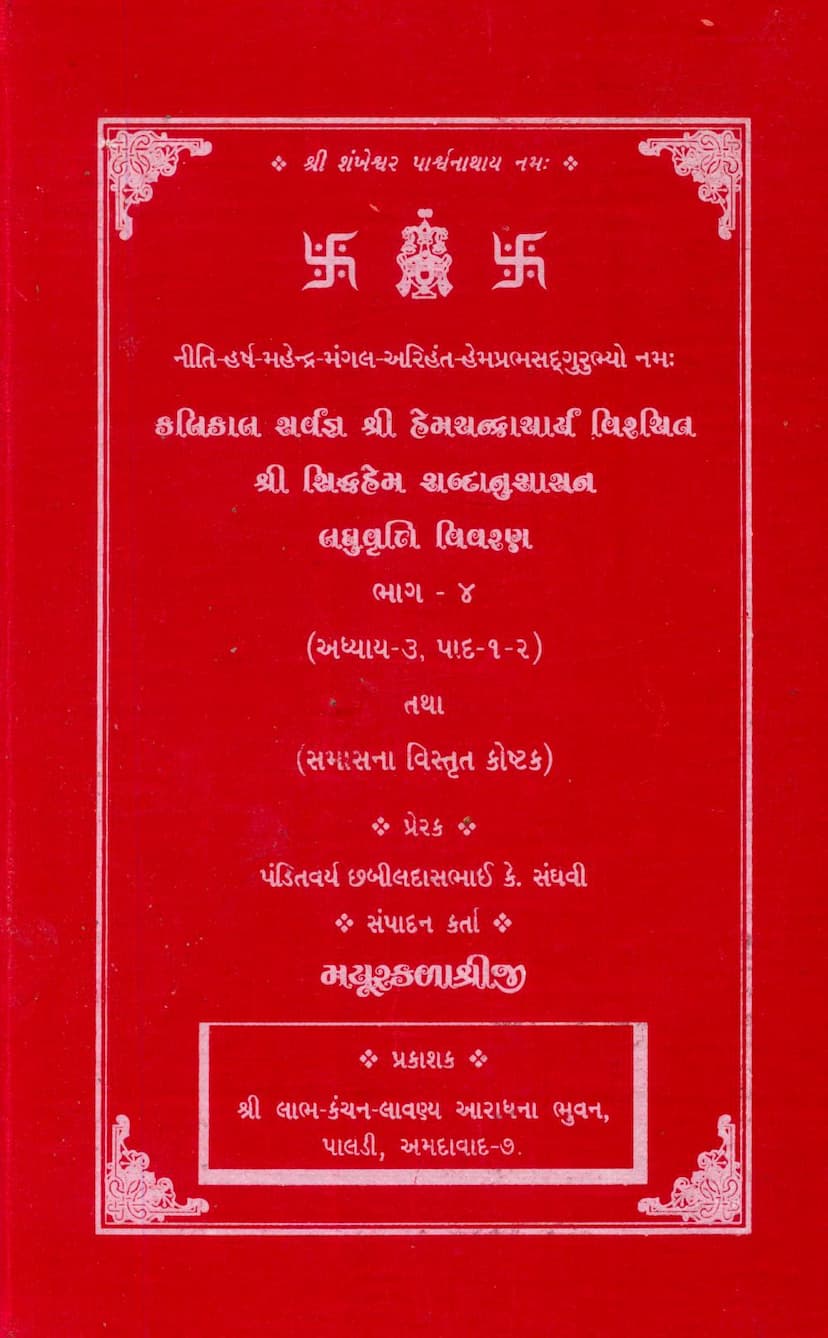Siddhhem Shabdanushasan Laghuvrutti Vivran Part 04
Added to library: September 2, 2025

Summary
Here's a comprehensive summary of the provided Jain text, "Siddhhem Shabdanushasan Laghuvrutti Vivran Part 04," authored by Mayurkalashreeji:
Overview and Context:
This document is the fourth part of a detailed commentary, "Laghuvrutti Vivran," on the "Siddhhem Shabdanushasan," a foundational grammar text authored by the renowned Jain scholar Hemchandracharya. The commentary is brought forth by Mayurkalashreeji, with the inspiration and guidance of Pandit Chhabiladas K. Sanghvi. The publisher is Shri Labh-Kanchan-Lavanya Aradhana Bhuvan in Ahmedabad. This particular volume focuses on the "Samas" (compounds) chapter, specifically covering sections 3.1 and 3.2 of the third chapter of the Siddhhem Shabdanushasan.
Key Themes and Content:
The document, particularly the "Prastavna" (Preface) by Pandit Chhabiladas K. Sanghvi and the introductory notes, highlights several important aspects:
-
The Importance of Prefaces: The preface emphasizes the necessity of prefaces in any literary work, as they provide a roadmap to the book's content, revealing its core secrets and outline. Reading a preface, especially for complex subjects like grammar, justice, or literature in Sanskrit, Prakrit, or Magadhi, can instill faith and reverence in the reader towards the book.
-
Grammar's Role: Grammar is presented as the foundation of polished language, providing clarity, purity, beauty, and distinction to speech.
-
Focus on Samas (Compounds): The volume specifically delves into the crucial topic of "Samas" (compounds) within grammar. The author, Mayurkalashreeji, along with her disciples, has undertaken extensive and diligent study of this section.
-
Previous Volumes and Future Plans: The preface mentions the preceding volumes:
- Part 1: Covered "Sanjna Prakaran," "Swar Sandhi," and "Vyanjan Sandhi" from Chapter 1 (Padas 1-3).
- Part 2: Covered "Shadling Prakaran" (six genders) from Chapter 1 (Pada 4) and Chapter 2 (Pada 1).
- The preface expresses a strong request for the early publication of Part 3, which is intended to cover "Karak Prakaran" (case relations), "Itva-Bitva Prakaran," and "Stree Ling Prakaran" (feminine gender).
- Part 4, the current volume, focuses on "Samas Prakaran" (compounds) from Chapter 3 (Padas 1-2).
-
Detailed Analysis of Samas: The book presents a thorough breakdown of compounds. It includes:
- Detailed explanations of sutras related to compounds from Chapter 3, Padas 1 and 2.
- A comprehensive table (originally planned for 24 columns, later adapted to 12 due to printing constraints) detailing the meaning, breakdown (vigraha), and other aspects of the compounds found in the sutras and the "Samasant Prakaran." A remarkable 1244 compounds are covered.
-
The Contribution of Mayurkalashreeji and Disciples: The preface acknowledges the significant effort of Mayurkalashreeji and her disciples, particularly Sadhvi Shri Kaishyashreeji M.Sa. and Sadhvi Shri Prashantayashashreeji M.Sa., for their meticulous and diligent work in studying and elaborating upon these grammatical principles. Their efforts are praised for deepening their understanding and contributing to the "kshayo-pasham" (reduction and subsidence) of their karmic obstructions related to knowledge.
-
Appreciation for the Teacher and Facilitator: The preface also expresses gratitude towards the inspirational figure Panditvar Chhabiladas K. Sanghvi for his persistent encouragement and guidance, and also for the efforts of Pandit Bhaveshbhai Ravindrabhai Doshi (the author's brother) in facilitating the publication.
-
Hemchandracharya's Genius: The preface extols the unparalleled intellect and profound scholarship of Kalikal Sarvajna Shri Hemchandracharya, highlighting his deep insights not only into grammar but also into various other subjects, leaving scholars in awe.
-
Request for Understanding and Forgiveness: The preface humbly requests the readers' understanding and pardon for any errors or repetitions that might have occurred due to the limitations of the printing process and the inherent challenges of compiling such a work. It concludes with a plea for forgiveness for any oversights or mistakes made unintentionally, offering "Trividh Trividh Michchha Mi Dukkruttam" (a Jain plea for forgiveness).
Content of Part 4 (Chapter 3, Padas 1-2 - Samas):
The actual text of Part 4, as indicated by the page content, begins with the grammatical analysis of sutras related to compounds. The commentary provides:
- Sutra Explanation: For each sutra, the text explains its meaning (artha) and then analyzes the compound (sutra).
- Detailed Analysis of Compounds: The breakdown includes the compound itself, its meaning (artha), the breakdown (vigraha), the grammatical category (e.g., Bahuvrihi, Tatpurush, Avyayibhav), and the specific sutras governing their formation.
- Examples and Counter-examples: The commentary uses numerous examples to illustrate the rules of compound formation, often providing counter-examples to clarify when a rule does not apply.
- Specific Compound Types Covered: The content includes explanations of various types of compounds such as:
- Avyayibhav Samas: Compounds where the first word is an indeclinable prefix that modifies the meaning of the second word.
- Tatpurush Samas: Compounds where the meaning of the second word is primary and the preceding words are governed by case relations. This section covers numerous sub-types of Tatpurush Samas based on the preceding case and the meaning of the compound.
- Bahuvrihi Samas: Compounds where a word not explicitly part of the compound determines the meaning of the entire phrase (e.g., "dwipatra" meaning "two-leaved," but the compound refers to the leaf itself).
- Dvandva Samas: Compounds where words of equal grammatical status are joined.
- Karmadharaya Samas: A sub-type of Tatpurush where the first word acts as an adjective to the second word.
The document meticulously analyzes each sutra with its examples, demonstrating how different rules of Sanskrit grammar apply to the formation of various compound words. The structure seems to follow a systematic approach of presenting the sutra, its meaning, and then dissecting the compounds with their grammatical analysis.
Overall Significance:
This volume, Part 4 of the "Siddhhem Shabdanushasan Laghuvrutti Vivran," is a significant contribution to Jainological and Sanskrit grammatical studies. It offers a deep and accessible understanding of the complex "Samas" chapter of Hemchandracharya's seminal work, making this knowledge available to students and scholars of Jainism and Sanskrit. The dedication to clarity and detail by Mayurkalashreeji and her team is evident throughout the text.